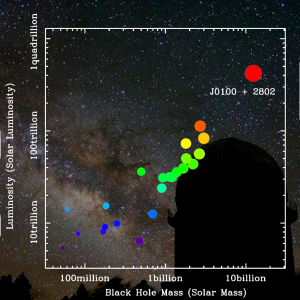Black hole bends former theories
 Physicists will have to re-adjust their theories, following the discovery of a mind-bogglingly big black hole.
Physicists will have to re-adjust their theories, following the discovery of a mind-bogglingly big black hole.
Australian scientists say a newly-discovered black hole is so big that it challenges the theory about how they grow.
The black hole – which has a mass 12 billion times that of the sun – is much larger than was assumed possible, given that it was born 900 million years after the Big Bang.
The formation of supermassive black holes is a field of research that is bathed in mystery.
But many scientists believe the growth rate of black holes was limited by the radiation pressure caused by absorbing mass.
As they pull things in, black holes grow, but the radiation pushes back.
“Basically, you have two forces balanced together which sets up a limit for growth, which is much smaller than what we found,” Fuyan Bian from the Research School of Astronomy and Astrophysics at the Australian National University (ANU) told reporters.
“Current theory is for a limit to how fast a black hole can grow, but this black hole is too large for that theory.”

The newly discovered quasar – dubbed SDSS J0100+2802 – has the most massive black hole and the highest luminosity of all known quasars.
The black hole was discovered by scientists led by Xue-Bing Wu at Peking University, China, as part of the Sloan Digital Sky Survey.
ANU researchers are running a similar project, known as SkyMapper, which is designed to enhance observations of the Southern Hemisphere sky.
More black holes are expected to reveal themselves as the project advances.







 Print
Print